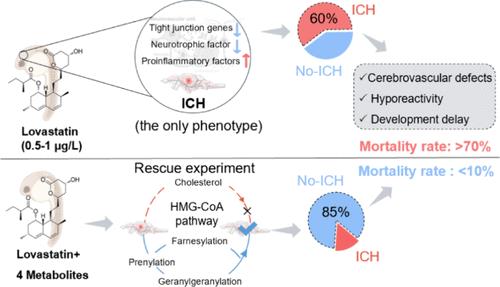斑马鱼颅内出血:洛伐他汀诱导的不良结果
IF 11.3
1区 环境科学与生态学
Q1 ENGINEERING, ENVIRONMENTAL
引用次数: 0
摘要
他汀类药物是世界上最常用的处方药之一,用于治疗高胆固醇血症,因此,他汀类药物在水生环境中的残留可能对非目标生物构成潜在风险。在这里,我们发现洛伐他汀在低浓度(0.5-1 μg/L)下导致斑马鱼幼虫颅内出血(ICH, 1 μg/L时约60%)和随后的慢性死亡率(1 μg/L时约70%)显著增加。超过50%的ICH幼虫在发育后期恢复,但严重的脑血管损伤(血管总长度、连接点和终点数量减少)和运动抑制持续存在。转录反应显示紧密连接、神经营养和促炎因子的显著改变。值得注意的是,恢复戊烯酰化而不是胆固醇生物合成的干预几乎完全阻止了ICH的发生,幼虫存活率达到60%。因此,我们的研究结果表明,水生环境中的脂质调节剂会削弱鱼类的脑血管系统,并导致慢性死亡,这一点不容忽视。本文章由计算机程序翻译,如有差异,请以英文原文为准。

Intracranial Hemorrhage in Zebrafish: An Adverse Outcome Induced by Lovastatin
Statins are one of the most commonly prescribed medications in the world, used in the treatment of hypercholesterolemia, and consequently, statin residues in aquatic environments can pose a potential risk to nontarget organisms. Here, we show that lovastatin causes a significant increase of intracranial hemorrhage (ICH, ∼60% at 1 μg/L) and subsequent chronic lethality (>70% at 1 μg/L) at low concentrations (0.5–1 μg/L) in larval zebrafish. Over 50% of the ICH larvae recovered late in development, yet serious cerebrovascular injury (decreased total vessel length, number of junctions, and end points) and locomotive inhibition persisted. Transcriptional responses indicated significant alterations in tight junctions, neurotrophic, and pro-inflammatory factors. Notably, intervention to restore prenylation but not cholesterol biosynthesis almost completely blocks the occurrence of ICH, with larvae survival rates reaching 60%. Thus, our results show that lipid-regulating agents in aquatic environments can weaken fish cerebrovascular systems and cause chronic lethality that should not be overlooked.
求助全文
通过发布文献求助,成功后即可免费获取论文全文。
去求助
来源期刊

环境科学与技术
环境科学-工程:环境
CiteScore
17.50
自引率
9.60%
发文量
12359
审稿时长
2.8 months
期刊介绍:
Environmental Science & Technology (ES&T) is a co-sponsored academic and technical magazine by the Hubei Provincial Environmental Protection Bureau and the Hubei Provincial Academy of Environmental Sciences.
Environmental Science & Technology (ES&T) holds the status of Chinese core journals, scientific papers source journals of China, Chinese Science Citation Database source journals, and Chinese Academic Journal Comprehensive Evaluation Database source journals. This publication focuses on the academic field of environmental protection, featuring articles related to environmental protection and technical advancements.
 求助内容:
求助内容: 应助结果提醒方式:
应助结果提醒方式:


